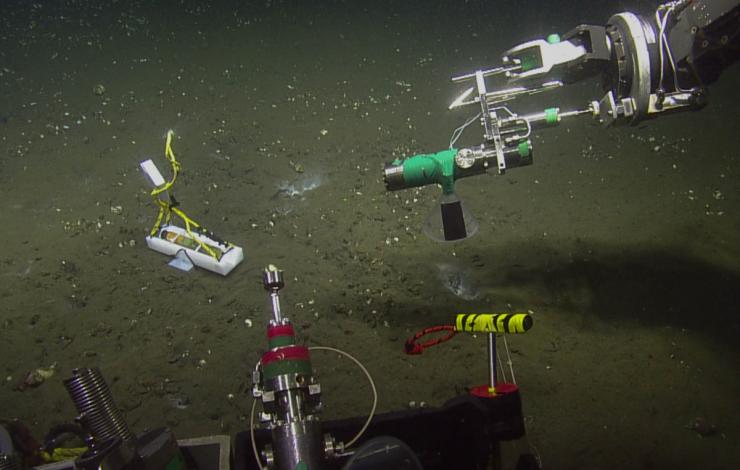PMEL's Acoustic and Earth-Ocean Interactions programs have successfully recorded the sound of methane bubbles from the seafloor off the Oregon coast using a hydrophone, opening the door to using acoustics to identify - and perhaps quantify - this important greenhouse gas in the ocean. Methane is found both as an icy hydrate deposit and in a gas phase within the sediments of the continental margins. The methane stored in the Cascadia margin, located offshore Washington, Oregon, and northern California, is of particular interest because the methane is stored within a major subduction zone which can potentially have an environmental impact on the upper water column and possibly the atmosphere.
In recent years, scientists have found hundreds of bubble streams emanating from methane deposits off the Pacific Northwest coast, but they have no way to determine how much methane is stored there. In 2016, researchers used the remotely operated vehicle (ROV) Hercules from the Ocean Exploration Trust's Exploration Vessel (E/V) Nautilus to deploy a hydrophone about 6 miles off Heceta Bank on the Oregon continental margin in 1,228 meters of water (about three-fourths of a mile deep). The acoustic signatures of the bubbles from the seep site are depicted in the hydrophone record as a series of short, high-frequency bursts, lasting 2-3 seconds.
"The bubbles in the streams make sound, and the frequency of the sound is related to the size of the bubble," said Robert Dziak, an acoustics scientist with the National Oceanic and Atmospheric Administration and lead author on the study. "The smaller the bubble, the higher the pitch. And the larger the bubble, the lower the sound pitch, but the more methane it contains.
The researchers then compared the sound record with still images from the ROV and found their estimates of bubble size from the hydrophone record matched the visual evidence. Results of the study have just been published in the journal Deep-Sea Research II.
On the current Nautilus research cruise mapping methane seeps, a hydrophone was deployed and recovered at various depths of Astoria Canyon in order to compare how bubble sizes and rates change with depth.
The next step, researchers say, is to fine-tune their ability to detect the acoustic signature of the bubbles so they can use the sounds to estimate the volume of methane in the offshore reservoirs. The ultimate goal is to be able to use sound to estimate the volume and rate of methane gas exiting the seafloor.



